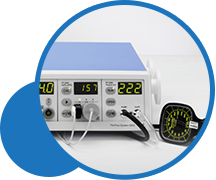
The most common diagnostic methods aiming to make a precise diagnosis of changes on blood vessels (arteriography and ultrasound) can not detect minor changes of smallest blood vessels. Therefore, the evaluation of changes is often done merely by a clinical exam and general appearance of a limb (color changes, quality of skin, wounds that open spontaneously, signs of gangrene, etc.). A device that enables precise diagnosis of changes on even very small vessels is Laser Doppler Flowmetry (LDF) and Transcutaneous Oxymetry (TcPO2). In many countries, radical surgery could not be performed without prior application of these methods. Simply spoken, these methods could establish the quantity of blood reaching the periphery and of oxygen delivered there.
The first such medical apparatus was introduced in Croatia by Oxy in 2003. Our specialists since then have had a chance to establish and evaluate the quantity of oxygen delivered to the tissues, to predict the success within reasonable expectations and to forecasts the dynamics of the healing process. The apparatus is also used in triage of candidates for HBOT. In some patients HBOT could not result in any beneficial effect. LDF and TcPO2 could be helpful in the decision making process. Other specialists, such as surgeons and dermatologists could only benefit from the results of such a diagnostics. The diagnostics is completely non-invasive and painless, and is not associated with any risk. The patient is put to rest and requested not to move for perhaps an hour or longer. Electrodes, fixed around the wound, measure oxygen content at atmospheric pressure, sometimes also while the patient is exposed to the increased pressure inside the chamber.
